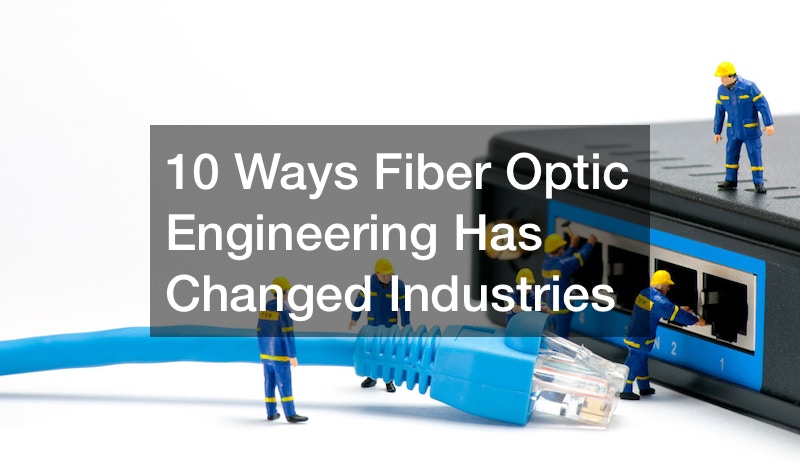
With an undeniable impact on modern technology, fiber optic engineering stands as one of the most revolutionary innovations of recent decades. Transforming industries across the spectrum, this technology has redefined communication, data transmission, and beyond. Operating at the speed of light, fiber optics has shattered conventional constraints, giving rise to advancements in telecommunications, healthcare, manufacturing, and numerous other sectors. Read on to discover ten profound ways through which fiber optic engineering has seamlessly integrated into diverse fields, ushering them into an era defined by unparalleled efficiency and connectivity.
1. Oceanography

Fiber optic engineering has brought a monumental transformation in the way we explore and understand the world’s oceans. Through the integration of fiber optic cables into underwater systems, scientists can now collect and transmit data in real time, providing unprecedented insights into oceanic processes. These cables facilitate the deployment of various sensors and monitoring devices across vast underwater expanses, enabling researchers to gather information on temperature, pressure, and marine life with exceptional precision.
Lidar (Light Detection and Ranging) systems, coupled with fiber optics, have emerged as a game-changer in oceanographic research. By emitting laser pulses and measuring their reflection off the water’s surface, lidar detection systems can accurately map the topography of ocean floors. Fiber optics play a crucial role in transmitting the lidar data to researchers ashore, allowing for continuous and high-resolution mapping. This innovation has transformed our understanding of underwater landscapes, fault lines, and geological features, contributing to enhanced earthquake and tsunami prediction, as well as advancing marine conservation efforts.
Incorporating fiber optic engineering into oceanography has also led to groundbreaking advancements in monitoring marine ecosystems. Fiber optic sensors can detect changes in water composition and quality, aiding in the early identification of pollution, harmful algal blooms, and other environmental hazards. The real-time data collection capabilities offered by fiber optics enable researchers and authorities to take swift measures to protect marine life and coastal communities.
2. Bail Bonds
The incorporation of fiber optics into the operations of bondsman services has streamlined communication and processes, transforming the way bail bonds are managed. With the integration of fiber optic technology, bondsman, who mediates the release of defendants pre-trial, now enjoy a vastly improved communication infrastructure. Information that once relied on cumbersome paperwork and physical presence can now be swiftly and securely transmitted through high-speed fiber optic connections.
In the world of bail bonds, where timely processing is paramount, fiber optics have revolutionized the exchange of crucial data. Electronic paperwork, signatures, and documentation can be effortlessly shared within seconds, expediting the entire bail process. This newfound efficiency is particularly vital in urgent scenarios, ensuring swift releases and legal proceedings.
Furthermore, the adoption of fiber optic engineering has facilitated virtual consultations and meetings for bondsmen. Clients, attorneys, and law enforcement agencies can convene seamlessly over high-quality connections, saving time and resources that would have otherwise been spent on travel. This shift towards digital interactions not only enhances convenience but also contributes to cost savings and a reduced carbon footprint.
3. Law
The legal field has experienced a profound shift due to the widespread adoption of fiber optic technology. Criminal law attorneys have harnessed the power of fiber optics to revolutionize how they gather, process, and present crucial information. By tapping into high-speed networks, legal professionals can access extensive legal databases, statutes, and documents with remarkable efficiency, transforming the research phase of building a case.
This transformation is particularly evident in e-discovery practices. Fiber optic connections facilitate swift retrieval of electronic evidence, expediting the analysis of digital records essential for constructing solid legal arguments. Moreover, the real-time data transmission capabilities of fiber optics facilitate seamless communication between attorneys, clients, and legal teams, regardless of their physical locations.
Courtroom dynamics have also experienced a significant makeover through fiber optic engineering. With rapid connections, attorneys can readily access multimedia presentations, videos, and digital exhibits, enhancing their persuasive abilities before judges and juries. This technology has redefined the sharing of complex information in courtrooms, making intricate legal matters more comprehensible and engaging.
4. Real Estate

The real estate industry has undergone a remarkable transformation with the integration of fiber optic engineering, impacting various facets from property transactions to communication. Within real estate law offices, the utilization of fiber optics has led to a surge in efficiency and productivity. According to the Fiber Broadband Association, properties with fiber internet access sold for an average of 3.1% more than properties without fiber access, making them highly attractive to buyers and renters alike.
Fiber optic networks have revolutionized property viewings and virtual tours, allowing potential buyers and tenants to explore properties remotely with unparalleled clarity. This shift has not only reduced the need for in-person visits but also facilitated global reach, enabling international clients to engage seamlessly in real estate transactions. Any real estate law office can now enjoy swift data transmission, expediting title searches, contract exchanges, and legal document processing.
The impact extends beyond individual properties. Smart home technologies, powered by fiber optics, have become a selling point for modern homes, influencing the preferences of tech-savvy buyers. Additionally, the integration of fiber optics has paved the way for sophisticated building management systems, enhancing energy efficiency, security, and tenant experience in larger real estate developments.
5. Education
The integration of fiber optic technology has ushered in a new era in education. This technology has not only revamped the way students learn but has also reshaped the entire educational landscape. Schools have embraced fiber optics to facilitate high-speed internet connectivity, enabling seamless access to digital resources, interactive learning platforms, and collaborative tools, ultimately enhancing the overall learning experience.
Fiber optic engineering has provided every center, be it a public or private school, with the means to establish virtual classrooms, enabling remote learning even in the face of unforeseen disruptions. This adaptability has proven invaluable, ensuring uninterrupted education during challenging times. Moreover, the increased bandwidth offered by fiber optics has facilitated live streaming of lectures, interactive discussions, and multimedia-rich content, enriching the pedagogical approach and engaging students on a deeper level.
Incorporating fiber optics into education has also expanded horizons beyond the traditional classroom setting. Virtual field trips, guest lectures from experts around the world, and real-time access to global information sources have become achievable. This has resulted in students’ exposure to diverse perspectives and enriching their educational journey.
6. Assisted Living
Another industry that has undergone profound change due to the integration of fiber optic engineering is assisted living, particularly within senior living facilities. Assisted living encompasses a variety of housing options tailored to meet the needs of older adults who require varying levels of support with daily activities. Fiber optic technology has emerged as a catalyst for transformation in these environments, yielding significant advancements in connectivity, communication, and the overall quality of life for residents.
Among the standout benefits, senior living facilities have harnessed fiber optics to provide residents with high-speed internet access, enabling them to stay connected with loved ones, participate in virtual activities, and access online resources. This connectivity has become an essential lifeline, mitigating feelings of loneliness and fostering a sense of community among residents. Moreover, the integration of fiber optic networks has enabled the deployment of smart technologies like remote health monitoring systems and emergency response mechanisms, enhancing resident safety and well-being.
Telehealth services have also been revolutionized through fiber optic integration within assisted living settings. Residents can now easily engage in virtual consultations with healthcare professionals, ensuring timely access to medical advice and reducing the need for frequent in-person appointments, especially for routine medical checks. All this introduces a new dimension to senior care.
7. Locksmithing

The locksmithing industry has been fundamentally reshaped by the emergence of fiber optic engineering, with a significant focus on the development of automated locks. These cutting-edge locks have ushered in a new era of security measures and access control methods, propelling the field of locksmithing into the digital age. The utilization of fiber optic technology has paved the way for the creation of highly advanced locking systems that rely on rapid data transmission, effectively enhancing both convenience and security.
Automated locks, powered by the capabilities of fiber optic connections, introduce a range of features that redefine traditional locking mechanisms. These locks enable remote access control and real-time monitoring, providing property owners with the ability to manage their locks from a distance. The seamless and swift data transmission facilitated by fiber optics ensures efficient communication between the locks and their associated control devices, minimizing delays and enhancing user experience.
Moreover, the incorporation of fiber optic engineering has bolstered the encryption and authentication mechanisms integral to automated locks. This technological enhancement serves to fortify the locks’ resistance to hacking attempts and unauthorized access. This heightened level of security is of paramount importance in safeguarding a variety of assets, ranging from high-value items to businesses and residential properties.
8. Hospitality
The hospitality industry, a colossal sector encompassing hotels, restaurants, and leisure services, has recently undergone a remarkable transformation. With the rise of outdoor dining and the increased reliance on digital services, fiber optics have played a pivotal role in enhancing guest experiences and operational efficiency. The global hospitality industry, estimated to be worth over $4 trillion as per statistics by the Market Data forecast, has embraced this technology to meet evolving consumer expectations.
First, fiber optic connections have enabled seamless digital interactions for customers. From providing high-speed internet access to facilitating mobile payments and contactless ordering, fiber optics have elevated the overall dining experience. This innovation has allowed hospitality establishments to adapt to changing health and safety protocols, ensuring a safe and convenient environment for patrons.
Furthermore, fiber optic engineering has revolutionized backend operations within the hospitality sector. It has streamlined reservation systems, inventory management, and communication between different departments. This has led to enhanced coordination, reduced wait times, and improved overall service quality, contributing to higher customer satisfaction rates.
9. Healthcare
Looking at transformation brought by fiber optic engineering, the healthcare sector shines as a prime example, emphasizing the saying ‘Connecting minds, healing lives.’ The technology has revolutionized healthcare delivery. With its unparalleled speed and connectivity, fiber optics have opened new avenues for remote consultations, telemedicine, and mental health support.
The healthcare industry has harnessed fiber optics to provide efficient telehealth services. These services enable patients to access medical professionals remotely, bridging geographical gaps and making quality healthcare more accessible. This has been especially significant in mental health services, allowing individuals to receive counseling and therapy from the comfort of their homes.
Besides, fiber optic technology has transformed medical data management, ensuring rapid and secure transfer of patient information between healthcare providers. This seamless data sharing has enhanced diagnosis accuracy and treatment coordination, benefiting patients’ overall care. Finally, here comes compassionate care and support that reaches individuals wherever they are.
10. Manufacturing

The manufacturing industry, which contributes over $2.3 trillion to the US economy alone according to data from the National Institute of Standards and Technology (NIST), has leveraged fiber optics to optimize its operations. Among other things, this technology has ushered in a profound transformation in the manufacturing sector, particularly within CNC (Computer Numerical Control) machinery and the production of lubricant products. The integration has propelled automation, precision, and efficiency to new heights, fundamentally altering how manufacturing processes unfold.
CNC machinery, pivotal in modern manufacturing, has experienced a revolutionary shift with the integration of fiber optics. High-speed data transmission facilitated by this technology empowers real-time communication between CNC machines and central control systems. This enables precise adjustments and quick responses, minimizing downtime and enhancing overall productivity. The outcome is not just increased output but also substantial reductions in operational costs.
In addition to these, fiber optic engineering has introduced advanced monitoring systems for CNC lubricant products. Through the integration of sensors connected via fiber optics, manufacturers can closely monitor lubrication levels in machinery. This proactive approach minimizes friction and wear, extending equipment lifespan and ultimately saving costs related to maintenance and replacements.
As we reflect on the many ways fiber optic engineering has changed industries, it’s evident that its impact reaches far beyond technological advancements. It’s about forging connections, optimizing operations, and enriching lives. This journey of innovation is a testament to human ingenuity and a glimpse into the boundless potential that the synergy of technology and human needs can unlock.



